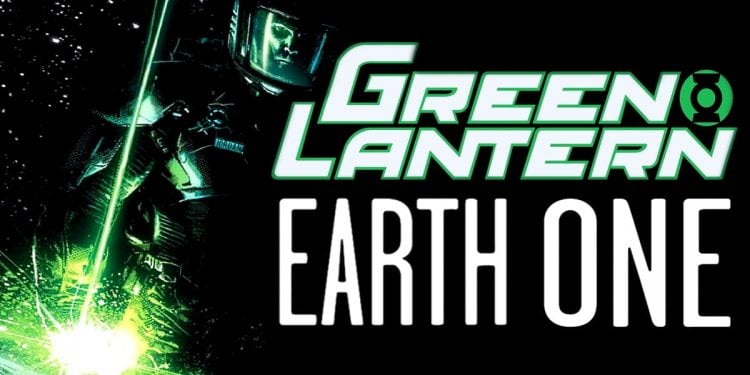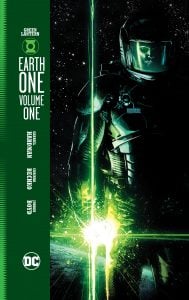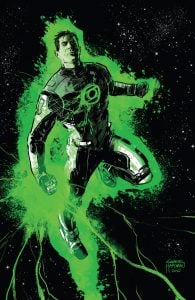
With the launch of the ‘Earth One’ line of original graphic novels, DC set about introducing twenty-first century reimaginings of their most iconic heroes. These new versions have been envisioned by all-star creative teams, including Grant Morrison and Yanick Paquette on ‘Wonder Woman’, J. Michael Straczynski and Shane Davis on ‘Superman’, and Jeff Lemire and Terry Dodson on ‘Teen Titans’. But now it’s time for the graphic novel line to head for the stars, with the arrival of ‘Green Lantern: Earth One’. Co-written by Corinna Bechko and Gabriel Hardman (with art by Hardman), the Hugo-nominated team best known for their work on titles like ‘Star Wars: Legacy’, ‘Savage Hulk’, and ‘Invisible Republic’, the book introduces readers to a brand new incarnation of Hal Jordan and the Green Lantern Corps. We were lucky enough to speak with Hardman and Bechko in advance of the book’s release, for a conversation that covered their take on Hal Jordan, the book’s artistic influences, and more.

To start things off, I’d like to ask about your personal history with Green Lantern. Was it something you read growing up? Is there an iteration you’re particularly fond of?
Gabriel Hardman: I mean, I certainly read Green Lantern stuff growing up. For the most part it would have been in the mid- to late-eighties. It was a prime time for me when I was a kid and it was a character I had affection for. But the first Green Lantern I was exposed to was John Stewart. So I’ve never had an idea that Hal Jordan was the only Green Lantern. But through that and particularly the Alan Moore short stories. I think the thing that impressed me the most about Green Lantern was that he could be a science-fiction character and you could see a lot of different worlds. Like ‘Tales of the Green Lantern Corps’, where you would see Lanterns you’d never heard of before in different circumstances and those stories that Alan Moore wrote, I mean… I feel like there’s one that maybe Bill Willingham drew that really impressed me, about a Lantern on a world where there was no light, and they had to have a bell… I always liked the bigger world of the Green Lantern Corps and that it could take you out to see different interesting stuff in the universe.
How did you first become involved with the ‘Earth One’ project? Did DC approach you or was there a pitch process?
GH: We were actually working on pitching something different to DC, which kind of fell through for complicated reasons, but we were on a phone call with Dan DiDio and he was like “Well, we’re open to hear other characters you’d be interested in,” and I just kind of blurted out Green Lantern, not for any good reason but because I had just read some the Silver Age ‘Green Lantern’ stuff. There was a Comixology sale and I picked up some of the old Gil Kane books and was looking through them and was excited by the idea of doing a sci-fi thing within the DC Universe. There are aliens and the kinds of things that we can do, and so I just kind of blurted it out and he said “Oh, well you could do an ‘Earth One’ book,” and we put together a pitch, pitched it, and it went pretty smoothly from there.

How would you sum up your take on Hal Jordan? What sets him apart from the mainline version and what are the core traits that had to be there?
GH: Well the biggest change is an external thing, because he is not chosen by the ring. We’re telling a story about a world where people have to make their own decisions in order to be heroes. It’s not about being the bravest person or a fearless person or any kind of traits that would absolutely transcend what a regular human being could do. He’s a lot more of an everyman sort of hero than he’s been portrayed as in the past, but he’s still highly skilled, in the world of this book he’s an astronaut, but that’s sort of a natural evolution from being a test pilot.
Corinna Bechko: And I think because we were changing things like that, we also wanted to make sure that since he’s a very well known Green Lantern and these are books for people that are maybe only vaguely aware of the different characters – even though other people can enjoy them as well – we wanted to make sure that some things were recognizable so we could make these other changes and it would work out and people would accept it.
On that note, whether it’s in characterization or visual design, the book does a lot to introduce familiar elements in a way that sometimes seems like it’s designed to throw a curve ball to any longtime readers who might pick this up. I imagine that can be a tricky line to walk. How do you do about balancing the new and the familiar in a book like this?
GH: I don’t actually think it’s a curve or a difficult line to walk. We set out to tell stories and we try to just ride the train of that story to the end of the line. We didn’t spend a lot of time handwringing about how particular choices would be perceived, because the story just demanded certain things and we did them. And I think that’s the only you can tell a story. If it’s a big calculation, then the reader is going to see that they’re being presented with something a little bit false. And we really just wanted to stay true to this version of Hal Jordan that we’d envisioned and stay true to the world that we’d envisioned, and we were able to express elements in that world through familiar characters sometimes and through familiar worlds. But it all felt like it was of a piece and natural.
In terms of the book’s visual design, there are a lot of really inventive alien environments throughout the story, some of which seem to draw on the styles of artists like Syd Mead or H.R. Giger. Can you tell us a bit about your influences in that regard?
GH: Well, Syd Mead and Giger are definitely influences. And there probably are a lot of filmic influences. You know, my other career is as an illustrator and storyboard artist on movies like ‘Inception’ and ‘Logan’, and because I’ve been so immersed in that world for so long, I’ll bring influences that are filmic into the comics. But a lot of people. You know, Mobius, or Ron Cobb, who’s an illustrator in film. All of this sort of stuff goes into the blender of inventing new worlds and stuff, but also you can’t help but be influenced by your influences, and that’s going to bleed into the book whether you deliberately try for it or not. But absolutely all those people are influences.
 This might be putting the cart before the horse, but by the end of the book it certainly seems as though you’re setting up a second volume. Has there been any talk of a sequel yet?
This might be putting the cart before the horse, but by the end of the book it certainly seems as though you’re setting up a second volume. Has there been any talk of a sequel yet?
GH: We haven’t talked about it at all. I mean, we personally have talked about it, and our intention was of course to tell a story that could go forward if the opportunity arose. But at the same time, our intention was to tell a story that had a beginning, middle, and end, that had a climax, that was satisfying enough in and of itself. If there are other books and we do further volumes, we have planned for that but that’s not essential to enjoy this book.
‘Green Lantern: Earth One’ will be due to hit shelves on March 20, 2018. For more on this and other upcoming ‘Earth One’ graphic novels, be sure to check back with ScienceFiction.com!
For more from Corinna and Gabriel, you can check out their creator-owned series ‘Invisible Rebuplic’, which is planned to return from hiatus in the near future. Additionally, Corinna is writing a children’s book called ‘Dig a Dinosaur’ for the Smithsonian and Gabriel is writing and drawing the ‘Aliens: Dust to Dust’ miniseries, the first issue of which is set for release on April 25.
